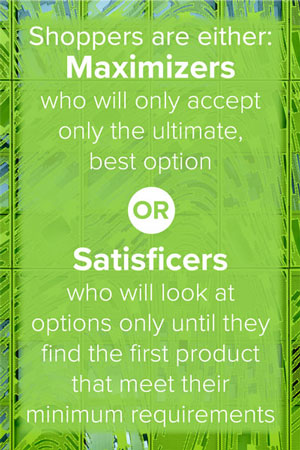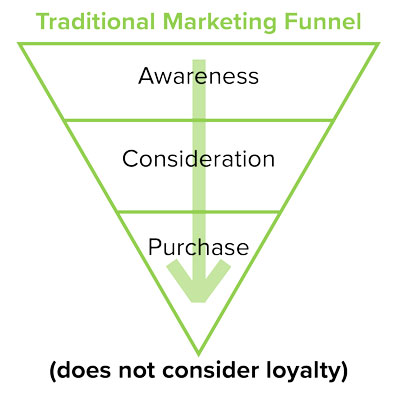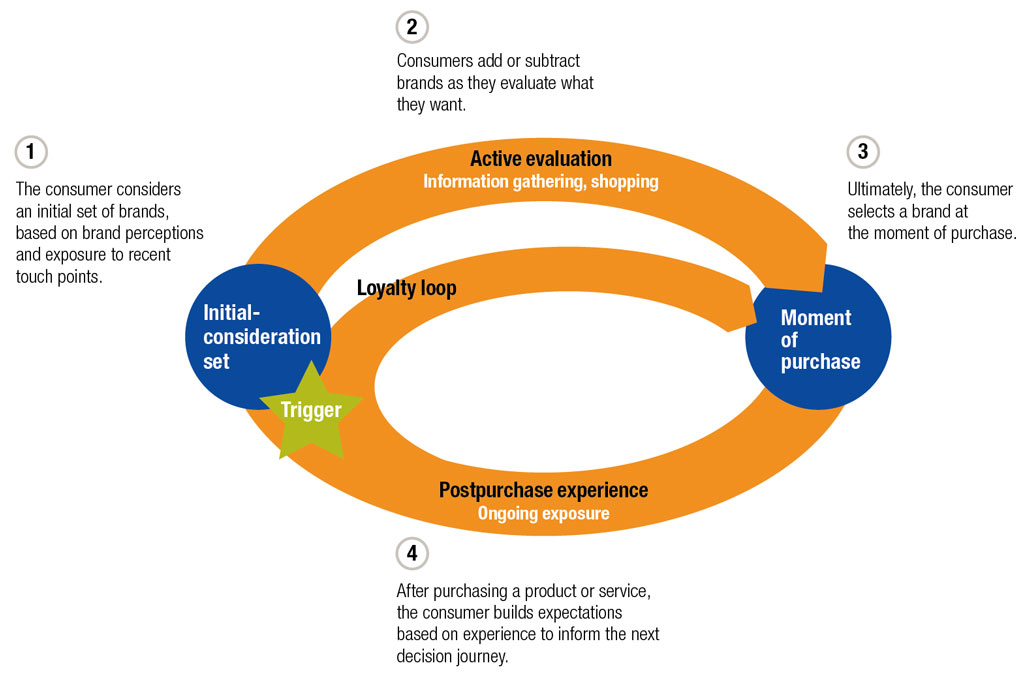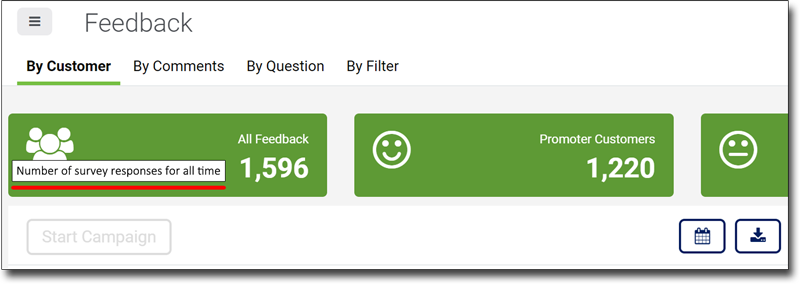February 2020
The Customer Loyalty Loop: Part 5
The Evolution of the Customer Decision Journey
People make decisions in different ways and therefore approach their shopping differently.
According to Barry Schwartz in ‘The Paradox of Choice,’ shoppers can be categorized into two main categories:maximizers andsatisficers8. Maximizers are shoppers who will only accept the ultimate, best option. They look at all of the options until they find a product that is absolutely the best choice for them. They might look at hundreds of products and won’t be satisfied until they have looked at every possible option. Satisficers, on the other hand, have a short list of criteria and will look at options only until they find the first product that meets those minimum requirements.
Think about the last time you bought a pair of shoes. If you went to the store and bought the first pair of shoes that fit the occasion and your feet, you’re probably a satisficer. If you went to the store, looked at all the options (including the sale rack), then left the store because you couldn’t find what you are looking for, then go to another store, then go home and shop online - you’re probably a maximizer.
Of course, customers have more information than ever in their shopping journeys to assist in making their decisions. The Internet forever changed many things, and shopping is one of them. Whether you’re shopping for a dress, a baby monitor, a blender, or a car - chances are you’re researching information online first (maximizers or satisfiers aside) and reading reviews. If you’re researching online for products, you can be sure your customers are researching you. For example, car customers today visit an average of only 1.6 dealerships before they make their purchase, compared to six dealerships just ten years ago9, which means they are heavily researching online before they go in. Where car shoppers used to rely on the car salesman to help them pick a car and discover which features they needed, car buyers practically already know which car they’re buying before they walk onto the lot.

60% of car research happens online10 and customers often know even more about the vehicle than the salesman! Information in the hands of customers is both democratizing for them and probably slightly terrifying for you. Businesses used to be able to frame their marketing and position their brand. In the world of the Internet, the customer has a voice in altering the public perception of your brand (more on that in Section 8, The Power of Customer Reviews and Testimonials).
How we think of our customers.
For ages, marketing practice posited that customers were filtered through a ‘marketing funnel.’ Your general audience was placed at the widest, top part of the funnel, when they were made aware of your product. The next phase includes a fewer number of people who decide to become more familiar with your product, and even fewer who actually consider purchasing it. The customers who actually purchase your product are funneled out the bottom, likely never to be seen again as gravity and time pulls them further from the purchase.
The fatal flaw in this model is that it leaves no room for customer loyalty. Once customers purchase, they exit the funnel, until they are later made aware again of the product and go through the whole process again. What if there was a way to take those customers who purchase from you and keep them engaged, leading to another purchase? Today, this customer decision journey is thought of more as a never-ending process, or a Customer Loyalty Loop.
The customer loyalty loop is similar to the traditional funnel in that customers move through different phases until they ultimately purchase, but the customer is more engaged in each phase of the customer loyalty loop. Yes, they have to enter the loop, but once they’re in, your job is to keep them in the loop. The customer enters the loop by a trigger - maybe an ad or a Google Search that lands them on a page of search results.
From there they enter the active evaluation phase, where they independently seek out information about your product and compare to other brands. At this point, they are ready to make their purchase. In the traditional marketing funnel, this ends the customer journey, but today we must maintain their engagement and keep them in the customer loyalty loop. After the purchase, the customer enters the post-purchase experience phase, perhaps the most important of the loop. The experience the customer receives at this point is where you have the opportunity to create lasting customer loyalty.
The Traditional Marketing Funnel is a one-way process, which moves customers through phases of awareness, consideration, and ending with purchase. It does not take into account customer loyalty.


The Customer Decision Journey
Source: McKinsey Quarterly11
Creating a Positive Remembered Experience
The last touch-point of any experience is always the most important. For example, imagine you went on a two-week vacation. You had a wonderful time and are ready to return home recharged and refreshed. Then, your flight gets cancelled and you spend two days in the airport. You finally get home and they lost your bags with the souvenirs you bought. And what is the smell in that taxi home from the airport? Probably when your friends ask how your trip was, you’re going to immediately delve into the horrible experience you had getting home. Now imagine you went on just a one-week vacation (not two), but had an easy trip home and even got a free drink on the flight. You’re likely to have much better memories of that trip that was half as long as the two-week vacation that ended poorly.
Similarly, if you go out for dinner and have a bad meal, you expect the owner/manager to take the time to come to the table and ask what went wrong, listen, and try to correct the issue. You might not leave 100% happy, but you feel a lot better about the experience than if they ignored the issue altogether. If the owner listens and tries to make it right, how would you describe your dining experience at that restaurant to your friends? What if the owner ignored you, and paid no attention to your poor meal? Now how would you describe your experience to your friends?
Your customers’ experiences are the same. If they are generally happy with the product but have a bad purchase or post purchase experience, they are going to remember the bad experience, not the quality product. It goes without saying that you would never even know if they had a bad experience if you don’t ask them about it. Carefully curating your messaging to your customers after their purchase is a key strategy in promoting customer loyalty.
Ways to Engage Your Customer in the Post-Purchase Experience:
- Gauge customer sentiment with Net Promoter ScoreSM (see Section 4).
- Remedy any poor experiences
- Senior staff contacts the customer immediately
- Genuinely listen to negative feedback
- Fix whatever process is causing the issue
- Offer refunds if necessary
- Offer discount for next purchase
- Reward promoters with exclusive offers, advance notice of product launches, free swag, etc.
- Let them know about other products you offer that would fit their needs
- Encourage promoters to leave an online review
8 Schwartz, Barry. The Paradox of Choice. New York, Harper Collins Publishers, 2004.
9 LeBeau, Phil. “Americans rethinking how they buy cars.” CNBC Web. 26 February 2014.
10 Turner, Channell. “Dealership Statistics That Every Dealer Should Know.” CBT Automotive Network. 11 April 2019.
11 David Court, Dave Elzinga, Susan Mulder, and Ole Jørgen Vetvik. “The Customer Decision Journey.” McKinsey Quarterly, 2009. pp. 1.
Website Testimonial Counts Explained
If you're using our Testimonial Publisher widget to display your customer reviews on your website, it displays a total number of reviews, but on your LoyaltyLoop dashboard you might find a different number of total responses. What's going on here?

Publisher Widget

LoyaltyLoop Dashboard
Your testimonial page, using the Testimonial Publisher widget, is reporting the total number of customers who have answered the "recommend" (NPS®) question and uses those answers to calculate how many stars to display. Your LoyaltyLoop dashboard displays a different result in the "All Feedback" section: The total number of reviews from every customer who has provided feedback.
If you have multiple locations and multiple surveys, all responses are shown in the "All Feedback" section, but the surveys do not require the NPS question to be answered. If a customer answers only the product quality question and not the NPS question, for example, they will be counted here and not on your testimonial page leading to the variation.
Remember, you can hover your mouse over many of the elements in LoyaltyLoop to learn what they are. If you hover over the "All Feedback" widget, a tooltip will appear that explains the value displayed, "Number of survey responses for all time".

Tips For Managing Users and Alerts
LoyaltyLoop Admin Users can control various aspects of your team members' access to LoyaltyLoop depending on your unique business needs. Understanding these controls, and setting your User accounts appropriately can make for a better user experience. Here are a few examples:
1. You can add, remove, and update your team members user account by going to Settings > User Settings.
2. From within a specific User's Settings, you can permit Users to have full Admin access, Standard access, or Read-Only access.
3. From within a specific User's Settings, you can control to which location or locations the user should have access (for multi-location customers).
4. Under Settings > Alerts & Notifications, you can assign LoyaltyLoop alerts to the appropriate team members so they can remain informed and in position to act on customer feedback.
5. TIP: We advise that you have at least two people assigned to receive Poor Survey Alerts. If you are unable to act on Poor Survey Alerts, for any reason (e.g. you are out on vacation), it's best to have at least one other person set to receive the alerts so they can respond in your absence.
If you have any questions or changes you need made, reach out to us at support@loyaltyloop.com. We'll be glad to help!